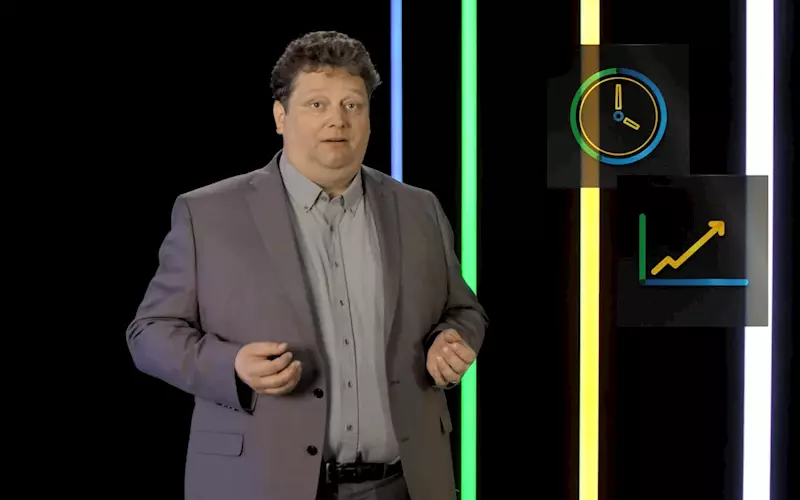Day five of Heidelberg Innovation Week: Heidelberg unveils new Mastermatrix die-cutter
Heidelberg took the wraps off its first Prinect-integrated die-cutter – the Mastermatrix 106 CSB – at the last day of the five-day Heidelberg Innovation Week.
25 Oct 2020 | By Aultrin Vijay
Raising the curtain for its new automated die-cutter, Heidelberg announced that the Mastermatrix 106 CSB was its first such die-cutting kit integrated into the digital Prinect Production Workflow. This, according to the company, is “a smart investment that quickly pays for itself”.
Jorg Dahnhardt, head of postpress business management at Heidelberg, unveiled the machine during a video presentation on the fifth day of the Heidelberg Innovation Week.
“Integration into the digital workflow reduce makeready times and increase production speeds and ensure the high output of this full 106 format blanker,” Dahnhardt said during the beginning of the presentation describing the benefits of the new die-cutting kit. “This is die-cutting in the performance class, and the further step in growth together with our partner MK Mastermatrix.”
However, high performance in converting doesn’t start with die cutting. “Production schedule starts from planning in the press room. Jobs are created in the new MIS – the Prinect Business Manager Packaging,” he said.
In the Prinect Scheduler, the jobs are put into the sequence and are processed. If die-cutting layouts are already being considered, makeready times in the finishing department are minimised in a targeted manner. “The entire press room and post-press system can therefore be optimised with this integrated workflow,” he added.
According to the company, the Mastermatrix is the first die cutter to be integrated into the digital Prinect Workflow. The data for a job is automatically available at the die-cutter and the operator selects the jobs on the touch reel. The pre-setting of the feeder intersection at the master feeder is provided from the Prinect system and adjustments for the sheet formats are fully automatic. This is said to avoid manual input errors, which shortens the makeready time.
Furthermore, two manual operations are said to be sufficient for the quick clock clamping mechanism for the 1mm cutting plate where previously six screws were used. “The innovative quick release for the MasterRake shortens the setup time by up to 70% and makes changeover much easier,” Dahnhardt explained.
He said the Mastermatrix also provides new technologies for production. “The new cam-driven platform ensures smooth, quiet operations even at 9,000 sph. An optimised gearbox ensures a smooth sheet transform.”
The number of nicks can also be reduced and the nicks themselves can be smaller, which in turn creates a high quality carton, Dahnhardt said.
Divulging more about the capabilities of the cameras present inside the system, Dahnhardt explained: “During production, the MasterSet optical register system runs with maximum precision. Cameras reprint the marks on the sheet and control the vacuum bar, which aligns the sheet with the gripper system. This ensures perfect print-to-cut registration accuracy for each sheet individually. The high die-cutting accuracy reduces waste and increases production reliability. MasterSet also enlarges the operational window and thus ensures more consistent and uninterrupted production.”
Masterset was developed by Heidelberg and launched by MK. According to the company, MasterSet uses three encapsulated servo drives, unlike linear drives that tend to get dirty. This is said to minimise the maintenance effort and improve the longevity of the machine.
For corrugated applications, cameras that read the backside of the sheet are also available. The machine automatically reduces the die-cutting pressure when it senses there is no sheet in the cutting station during pallet change or while inserting an entire sheet. This prevents contact between the tool and the die cutting plate, and improves the service life of the tool.
“Die-cut and stripped test sheets can be removed for quality control at the touch of a button during operation. The dynamic component of the die cutting and blanking process is fully maintained as the machine run is not interrupted. The die-cut sheet is stripped and passed through the blanking station without a stroke. The grippers transfer the sheet to the conveyor belt. The test sheet is guided via diverter to a separate table at the delivery of the machine. The waste conveyor is video monitored as are the pallet logistics systems and the feeder and delivery. The operator has everything in view, thanks to these three cameras. He can intervene at an early stage if necessary. This increases production reliability,” Dahnhardt explained further.
He said with the web based Prinect portal, the jobs in progress can be tracked in real time on a smart device. “Once a job has been completed, the production data are available for reporting. Everything is documented. This guarantees a clear overview and enables long term analysis with smart business intelligence,” he added.
Dahnhardt revealed that Heidelberg, in association with MK Masterwork, have doubled its product portfolio in the last four years and have installed more than 500 machines worldwide.
“The Diana folder gluers are now available in four different performance classes. With the Promatrix 145 CSB, we have established a blanker in a large format. With the Mastermatrix presented for the first time today, we are opening up a new class of productivity - digitally integrated, innovative and profitable. A smart investment,” he concluded.














 See All
See All